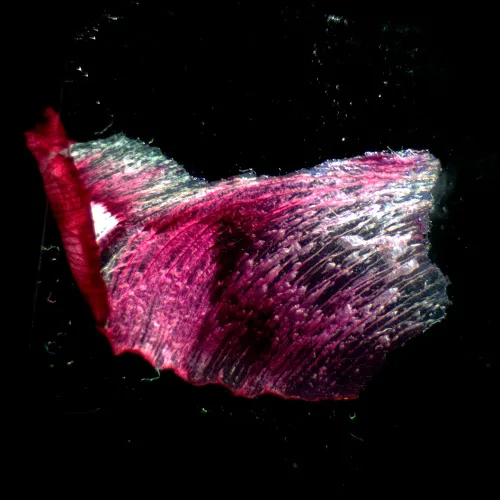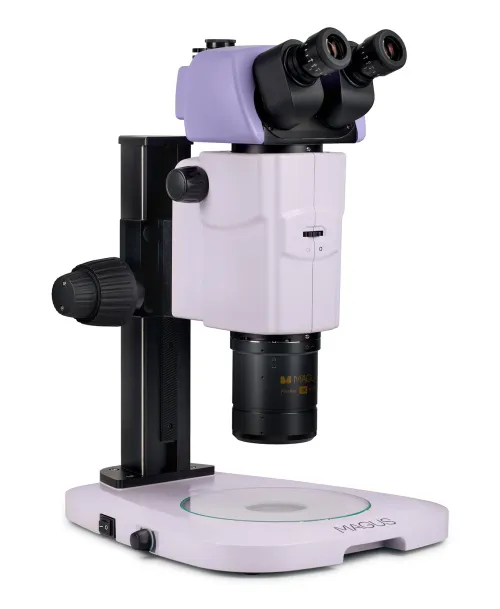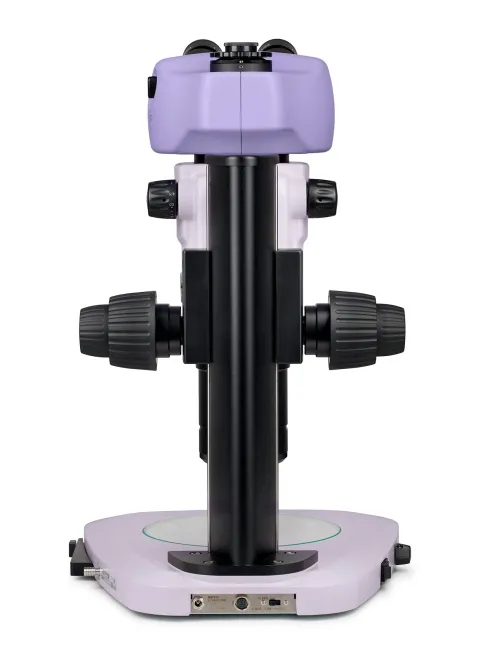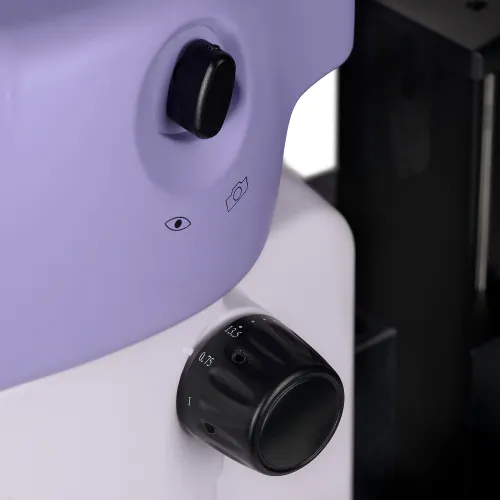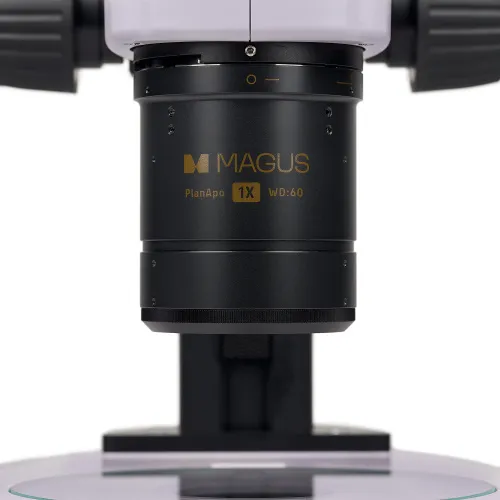MAGUS Stereo A18T Stereomicroscope
Magnification: 7.3–135x. CMO system. Trinocular head, plan apochromatic objective, 10W LED transmitted light illuminator
| Product ID | 83490 |
| Brand | MAGUS |
| Warranty | 5 years |
| EAN | 5905555019567 |
| Package size (LxWxH) | 75x62x50 cm |
| Shipping Weight | 13 kg |
MAGUS Stereo A18T is a stereomicroscope designed according to the CMO system. The model belongs to the research class and is equipped with apochromatic optics. A stereoscopic microscope allows you to study objects in volume, explore the features of their relief, and assess their depth. The CMO design provides a large field of view, high resolution and authentic color reproduction. The image of the object is formed without geometric distortions: Its form is reflected accurately, and so the researcher does not have to mentally correct them and the work process is not tiring.
In the basic configuration, the microscope works with transparent and translucent objects in transmitted light. With additional accessories, the model allows for working in the darkfield method as well as in fluorescent or polarized light. A digital camera can be installed in the microscope and the research process can be recorded or transmitted to a screen.
The MAGUS Stereo A18T microscope is suitable for work and research in the field of medicine – including IVF – biology, forensics, and other examinations, materials science, and microelectronics as well as for quality control and studying the properties of objects in industry.
This microscope has a trinocular head with a separate vertical channel for a digital camera. The beam splits 100/0 or 0/100. Switching occurs between the right eyepiece tube and the trinocular tube and does not affect the left eyepiece tube. The trinocular head inclination angle is 20°. The eye relief can be adjusted by rotating the tubes around their axis.
A zoom objective in each of the eyepiece tubes simultaneously changes the magnification and focal length. As a result, the object is always displayed sharply and in focus – even when changing magnification. Zoom ratio: 18:1. The image of the object is formed upright.
The main objective is installed strictly perpendicular to the plane of the object. This arrangement forms a correct image of the object without geometric distortions. The stereoscopic angle is 11°. The main objective magnification is 1x and the aperture is 0.15. Apochromatic optics correct spherical and chromatic aberrations for multiple colors. Working distance: 60mm.
To adjust the focus, the stand has two knobs located on both sides. The knobs adjust the coarse and fine settings.
The stage is equipped with a glass insert, on which samples are placed for examination in transmitted light. The base has a black plate for implementing the method of oblique illumination in transmitted light. The position of the plate is controlled by the adjustment slider on the right side of the base. Next to the slider is a rod that is responsible for the input and output of the prism for working with different magnifications.
A light-emitting diode serves as the illuminator of transmitted light. Its power is 10W, which is sufficient for research not only in the brightfield but also in polarized light or using the darkfield method. The LEDs are designed to provide 50,000 hours of operation.
Key features:
- 18:1 zoom objective lens smoothly changes magnification and focal length
- Plan apochromatic main objective with a large field of view and correction of a significant number of chromatic and spherical aberrations
- Research grade stereo microscope that is suitable for a wide range of applications, including IVF
- Equipped with a stationary transmitted light illuminator. With the installation of additional equipment, it can operate in fluorescent and polarized light using the darkfield method
- The trinocular head supports the installation of a digital camera
The kit includes:
- Base with built-in transmitted light source, device for implementing the oblique illumination method and prism for working with different magnifications
- Stand with a focusing mechanism
- Trinocular head
- Zoom objective 0.75х–13.5х
- Plan apochromatic main objective 1x
- Eyepiece 10x/23mm with diopter adjustment (2 pcs.)
- Glass plate
- Power adapter
- Dust cover
- User manual and warranty card
| Product ID | 83490 |
| Brand | MAGUS |
| Warranty | 5 years |
| EAN | 5905555019567 |
| Package size (LxWxH) | 75x62x50 cm |
| Shipping Weight | 13 kg |
| Type | stereo/instrumental |
| Microscope head type | trinocular |
| Head inclination angle | 20° |
| Magnification, x | 7.5 — 135 |
| Zoom ratio | 18:1 |
| Eyepiece tube diameter, mm | 30 |
| Eyepieces | 10x/23mm |
| Objectives | main objective: plan apochromatic 1x NA 0.15; zoom objective lens: 0.75–13.5x |
| Working distance, mm | 60 |
| Interpupillary distance, mm | 52 — 116 |
| Linear field of view, mm | 31.4 |
| Stage features | glass plate |
| Eyepiece diopter adjustment, diopters | ±5D on each eyepiece |
| Eyepiece diopter adjustment | ✓ |
| Diaphragm | adjustable iris (from 0 to 2.5mm) |
| Focus | coaxial, coarse (60 + 90mm) and fine (0.002mm) |
| Illumination | LED |
| Brightness adjustment | ✓ |
| Power supply | 85–265V, 50/60Hz, AC network |
| Light source type | 10W LED |
| Operating temperature range, °C | 5...+35 |
| Additional | stand base: 365x314mm, with a device for implementing the oblique lighting method |
| User level | experienced users, professionals |
| Assembly and installation difficulty level | complicated |
| Optical scheme | CMO stereomicroscope |
| Application | laboratory/medical, for applied research |
| Illumination location | lower |
| Research method | bright field |
| Pouch/case/bag in set | dust cover |
We have gathered answers to the most frequently asked questions to help you sort things out
Find out why studying eyes under a microscope is entertaining; how insects’ and arachnids’ eyes differ and what the best way is to observe such an interesting specimen
Read this review to learn how to observe human hair, what different hair looks like under a microscope and what magnification is required for observations
Learn what a numerical aperture is and how to choose a suitable objective lens for your microscope here
Learn what a spider looks like under microscope, when the best time is to take photos of it, how to study it properly at magnification and more interesting facts about observing insects and arachnids
This review for beginner explorers of the micro world introduces you to the optical, illuminating and mechanical parts of a microscope and their functions
Short article about Paramecium caudatum - a microorganism that is interesting to observe through any microscope



